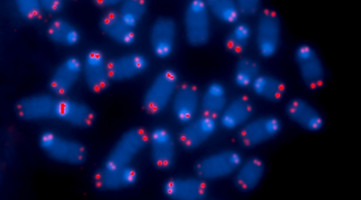
The plastic tips attached to the ends of shoelaces keep them from fraying.
Telomeres are repetitive DNA (deoxyribonucleic acid) sequences that serve a similar function at the end of chromosomes, protecting its accompanying genetic material against genome instability, preventing cancers and regulating the ageing process.
Each time a cell divides in our body, the telomeres shorten, thus functioning like a molecular "clock" of the cell as the shortening increases progressively with aging.
An accurate measure of the quantity and length of these telomeres, or "clocks", can provide vital information if a cell is ageing normally, or abnormally, as in the case of cancer.
To come up with an innovative way to diagnose telomere abnormalities, a research team led by Assistant Professor Cheow Lih Feng from the NUS Institute for Health Innovation & Technology (iHealthtech) has developed a novel method to measure the absolute telomere length of individual telomeres in less than three hours.
This unique telomere profiling method can process up to 48 samples from low amounts (<1 ng) of DNA.
Their work was published in the journal Science Advances.
"Our innovation could greatly enhance the speed of diagnosis and simultaneously provide critical telomere information for age-related diseases and cancers. Such a clinically reliable tool that is able to provide accurate telomere profiling will allow for precision therapy and targeted treatments for patients," explained Asst Prof Cheow, who is also from the NUS Department of Biomedical Engineering.
Conventional methods for telomere measurements in clinical settings are often time-consuming and require skilled operators.
These methods are also lacking in precise information on individual telomere lengths and quantities required to accurately diagnose, or determine telomere abnormalities.
To overcome the major technical impediments in performing telomere profiling, Asst Prof Cheow and his team have developed a unique system called Single Telomere Absolute-length Rapid (STAR) assay.
Using this method, individual telomere molecules are first distributed into thousands of nanoliter chambers in a microfluidic chip.
Real-time polymerase chain reaction (PCR) of single telomere molecules is then performed across all the chambers in a massively parallel manner.
The PCR amplification kinetics in each nanoliter chamber reflects the telomere repeat number, which directly correlate to the length of a single telomere molecule.
Using the STAR assay, the researchers can accurately determine the telomere maintenance mechanism in cancer cells and obtain a high level of detailed information in the measurements.
Patients who have cancers activated by the Alternative Lengthening of Telomere (ALT) pathway - such as certain sarcomas (cancer of connective tissues) and gliomas (cancer of brains) - are often shown to have poor prognosis that is linked to longer than average telomere length and a high percentage of critically short telomeres.
In addition, their cancer cells also were found to possess extra copies of telomere molecules.
To test the invention, the NUS iHealthtech team collaborated with Dr Amos Loh from the Department of Paediatric Surgery at KK Women's and Children's Hospital (KKH).
The team chose to work with KKH to validate the assay as telomere alteration mechanisms like ALT are best studied in tumours like sarcomas, and neuronal tumours like gliomas and neuroblastoma that have a higher incidence among children.
The validation has proven the STAR assay to be effective in diagnosing the ALT status in paediatric neuroblastoma, which can serve as a useful prognosis indicator for this cancer.
Cancer cells utilise a modified mechanism to abnormally modify and maintain the length of their telomeres, as a means to allow them to grow continually.
Mechanisms like ALT are exploited particularly by cancers like neuroblastoma.
Neuroblastoma is a cancer that arises from nerves in various parts of the body and is the most common solid malignant tumour in children.
It is also responsible for a disproportionate number of childhood deaths from cancer.
"Previously less recognised in patients, telomere abnormalities like ALT have been recently identified to be a new risk marker in neuroblastoma. Since neuroblastoma with telomere abnormalities have poorer outcomes, this new method of measuring telomeres can now facilitate simpler and more rapid identification of ALT in patients to more accurately define their disease prognosis," said Dr Amos Loh, Senior Consultant, who is from KKH's Department of Paediatric Surgery.
The development of the STAR assay is supported by the National Medical Research Council.
Asst Prof Cheow shared, "The combination of rapid workflow, scalability and single-molecule resolution makes our system unique in enabling the use of telomere length distribution as a biomarker in disease and population-wide studies. It will be particularly useful for diagnosing telomere maintenance mechanisms within clinical time scales, to determine personalised, therapeutic or preventive strategies for patients".
The NUS iHealthtech team is looking to extend their research and apply the STAR assay platform for use in hospital settings, to facilitate the diagnosis of ageing-related diseases.
Source: National University of Singapore
The World Cancer Declaration recognises that to make major reductions in premature deaths, innovative education and training opportunities for healthcare workers in all disciplines of cancer control need to improve significantly.
ecancer plays a critical part in improving access to education for medical professionals.
Every day we help doctors, nurses, patients and their advocates to further their knowledge and improve the quality of care. Please make a donation to support our ongoing work.
Thank you for your support.